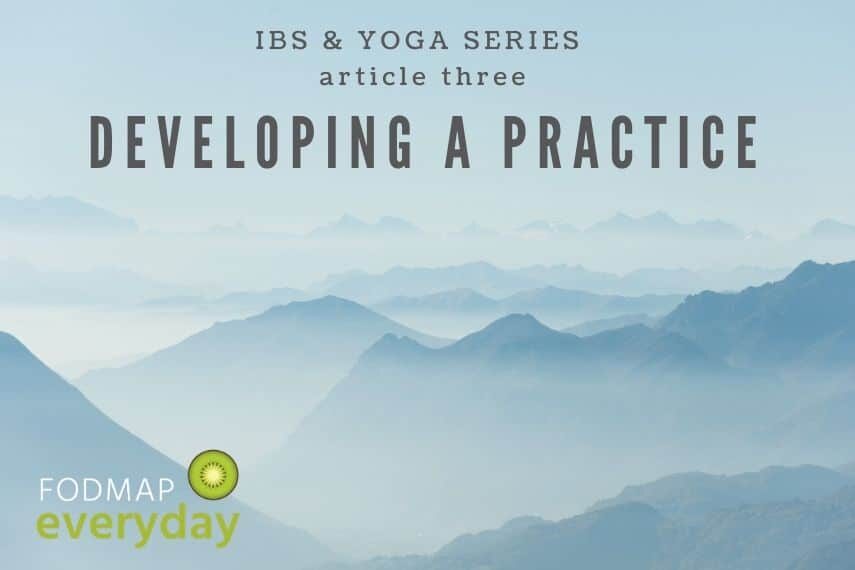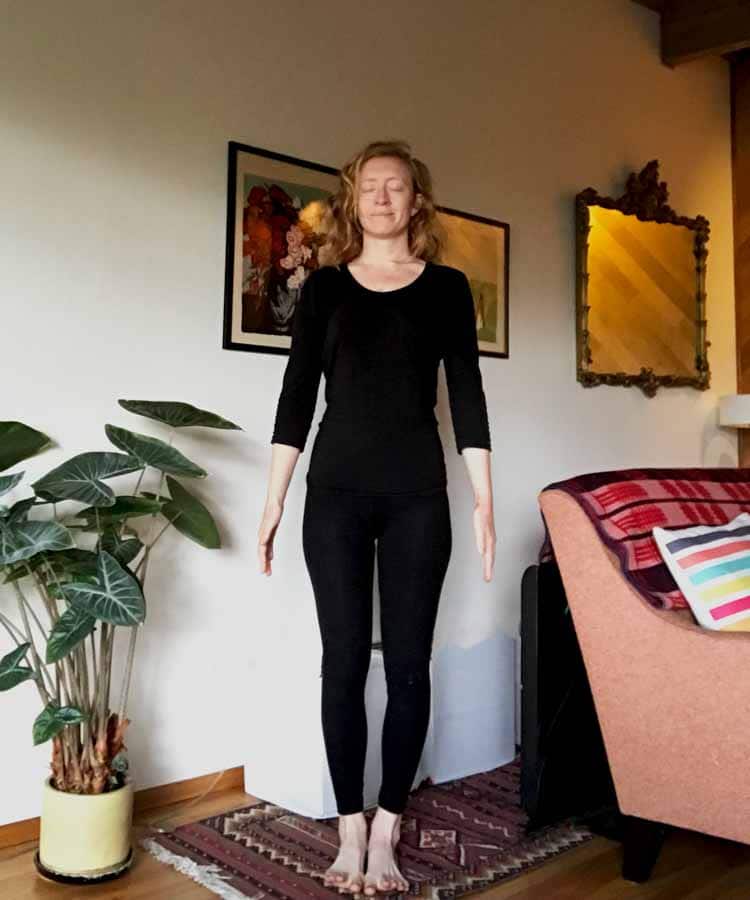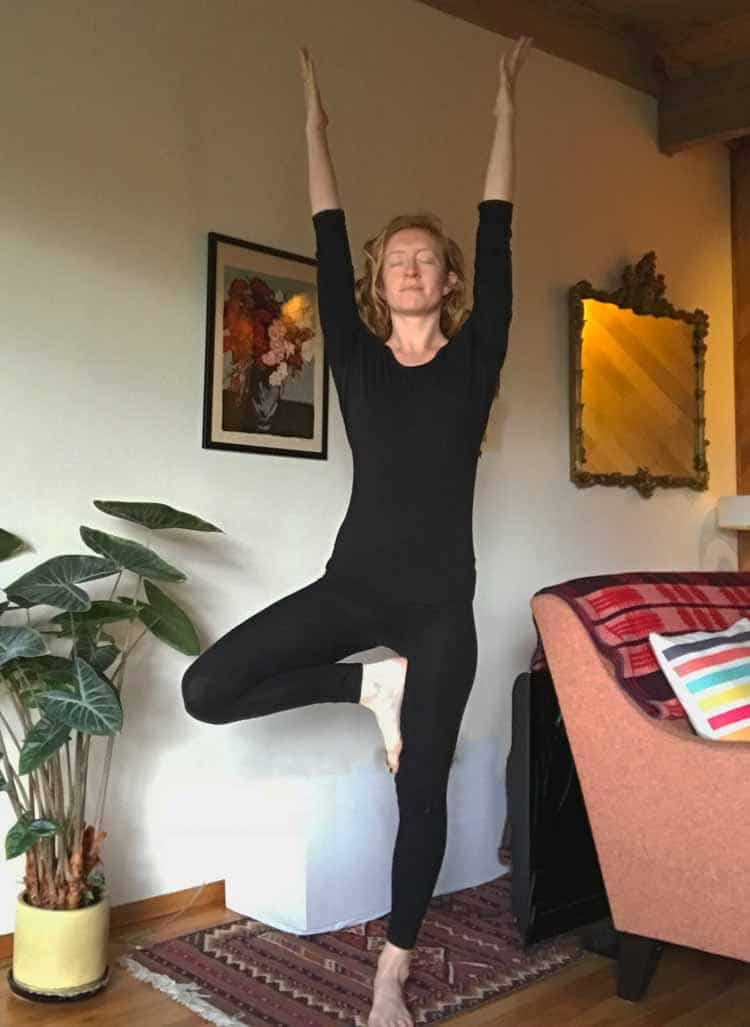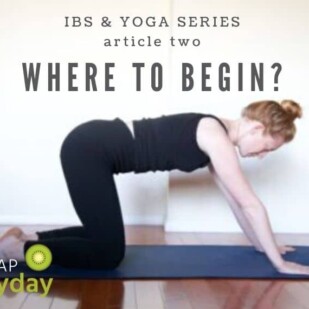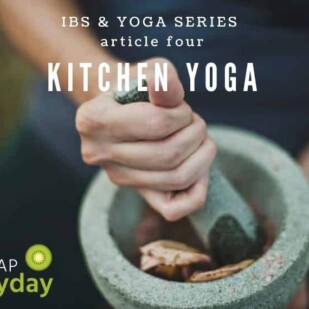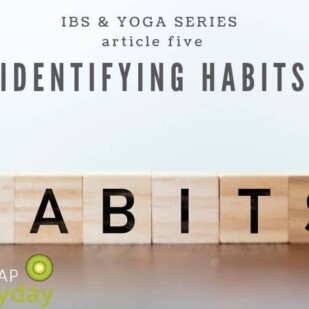This is the third article in the IBS and Yoga Series “It’s Your Body!” where we help you explore ways of learning to listen to your body. You can find the introduction here. You can read all of the series here. And be sure to read our interview with Kiera.
Steadiness and Ease
When undertaking any somatic body practice it is helpful to consult the foundational philosophy behind the practice. While there are many important texts in understanding the principles of yoga, the one we will focus on is a verse from the Yoga Sutras of Patanjali. “Sthira Sukham Asanam” (postured easeful steadiness) appears as a verse in the Yoga Sutras as Patanjali’s basic physical requirement for entering a meditative state.
We can apply this fundamental principle of an asana practice to bring steadiness and ease to a distressed gut.
Dis-Ease and the Gut
These concepts apply to our conversation of dealing with IBS because dis-ease (feeling ill, chronic pain, indigestion) and erratic activity (inflammation, diarrhea, constipation, gas) are the direct and tangible opposites of steadiness and ease, and they are also often at the root of IBS for many people.
This connection is one of the reasons yoga and other engaged somatic practices are so effective in helping to relieve symptoms of IBS. When the gut goes about its job from a place of steadiness and ease, IBS symptoms may be alleviated.
Developing a mindful somatic practice provides useful tools for checking in with your digestive and other bodily processes.
The Impact of Practice
What you practice on your mat will start to make its way into the rest of your life. For example, if you are working on moving one toe at a time, you might notice the grace and ease with which your fingers fly around a keyboard all day, independent of each other, and with a soft wrist – and channel that dexterity into your toes!
Or, if you are working on the foundations and lines of action in Tadasana (Mountain Pose – described below) in your practice on the mat, you might find yourself standing at the sink, washing dishes and paying more attention to whether your weight is balanced between your feet, or checking that your abdominal muscles are engaged, with your tailbone gently reaching down.
Your practice has informed you that if you adjust your standing position according to these known lines of action, the posture will be comfortable and sustainable (easy and steady). Slowly, and over sustained time and gentle effort, you will become what you practice.
Your Body — Your Mind
When beginning your yoga practice it might be helpful to put aside any assumptions you may have about the terms “steadiness and ease” until you come to feel their meaning through your experience of what is happening for you.
Over the course of time, many have concluded that the attainment of a steady and easeful state reflects a highly functioning, healthy system. Developing your own personal meaning of “steadiness and ease” is an essential element of an effective and evolving somatic practice.
Trusting Your Gut (pun intended!)
We encourage you to explore the meaning and value of seeking and attaining “steadiness and ease” as part of your journey towards greater health.
When starting a new practice take the time to notice how you are feeling. Do the concepts and suggestions sit well with you? Do they ring true to you? Do acknowledging and noticing these concepts in your own postural practice deepen your practice? Do you feel more balanced? Do you feel healthy? Have these come to you on your own some other time, in some other place?
This exploration of Sthira Sukham Asanam, or just the words sthira and sukha, is just meant as a brief reminder to take notice of the way things feel, juxtaposed and balanced. Try and notice where you feel like this naturally in your life. Try and notice this when you eat and when you exercise, sleep or socialize. Just let these soft, compact words sit in the back of your mind, meditate on what they mean to you, or forget about them completely, and see if they arise naturally in your own practice.
Two Yoga Asana’s to Practice and Develop Steadiness and Ease
To bring these concepts into practice, let’s look to the trees and the mountains.
Tadasana (Mountain Posture)
Think of the characteristics of a mountain, serenely standing, imperceptibly shifting, infinitely steadfast, and peacefully reaching up towards the sky and down towards Earth’s center. Think of your own description of a mountain’s way of being.
- Stand at the top of your mat with feet parallel and slightly separated, arms by your sides.
- Reach up through the top of your head, keeping chin level to the ground, and feel the spine lengthen, as though a rope is pulling in two directions – towards the sky from the top of your head – and towards the center of the Earth, from the bottom of your feet.
- Balance your weight left to right, and front to back. Press into the balls of you feet and the heels.
- Engage your abdominal muscles gently, inwardly rotate your thighs and release your tailbone down.
- Soften your ribs.
- Breathe evenly and fully.
- Close your eyes, and notice yourself, notice your surroundings, notice your balance, notice if you could stay here for a long time, or if you are in discomfort.
Vrksasana (Tree Posture)
Trees are an excellent example of Sthira Sukham Asanam. Take a walk and observe the trees, take note of your observations and bring them back to your mat. They remain upright without rigidity. They energetically and emphatically reach up, out, and down, but the leaves and the ends of the branches playfully wave this way and that, responding to the wind and rain and change of the season with a gentle grace.
- Stand tall in Tadasana (see above)
- Find a focal point somewhere on a wall in front of you to help with your balance.
- Bend one knee and draw the knee up to hip level.
- Take hold of the knee and draw it out to the side.
- Place the raised foot against your thigh, calf, or ankle (Depending on flexibility, do not place the weight of the foot on the knee)
- Press your palms together in front of your chest in a prayer position.
- Press the raised foot into the thigh, and the thigh back into the foot, and draw in and up through the midline of your body, gently lengthening your spine.
- Reach your arms overhead and separate your palms.
- Think of a tree, think of the leaves playing at the ends of your fingertips, smile at the stability of your roots reaching far into the ground. If you fall over, be kind to yourself, take a few breaths, and reach again for the light of the sun.
Keep practicing!
READ NEXT: IBS & Yoga Series: Kitchen Yoga
